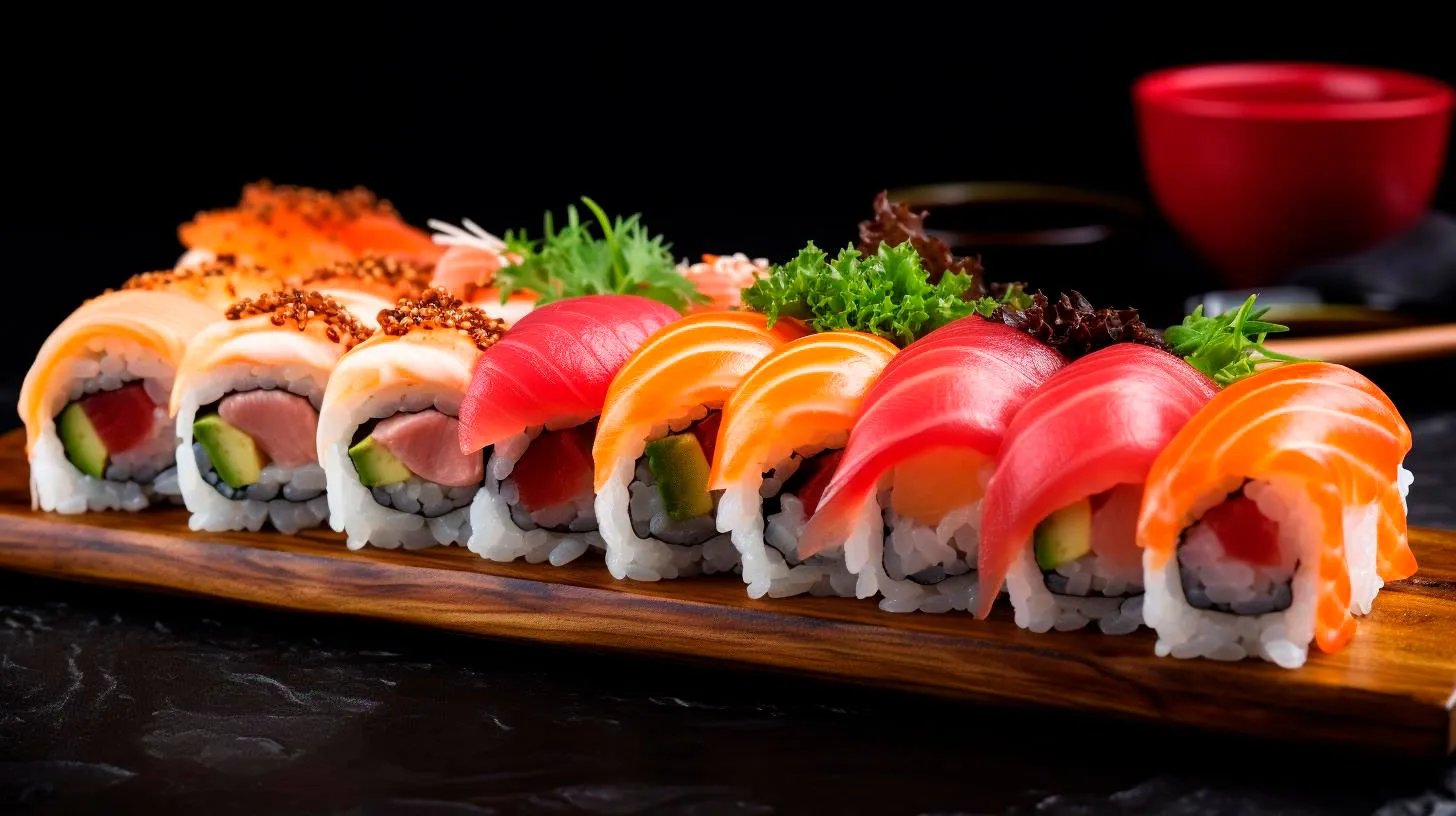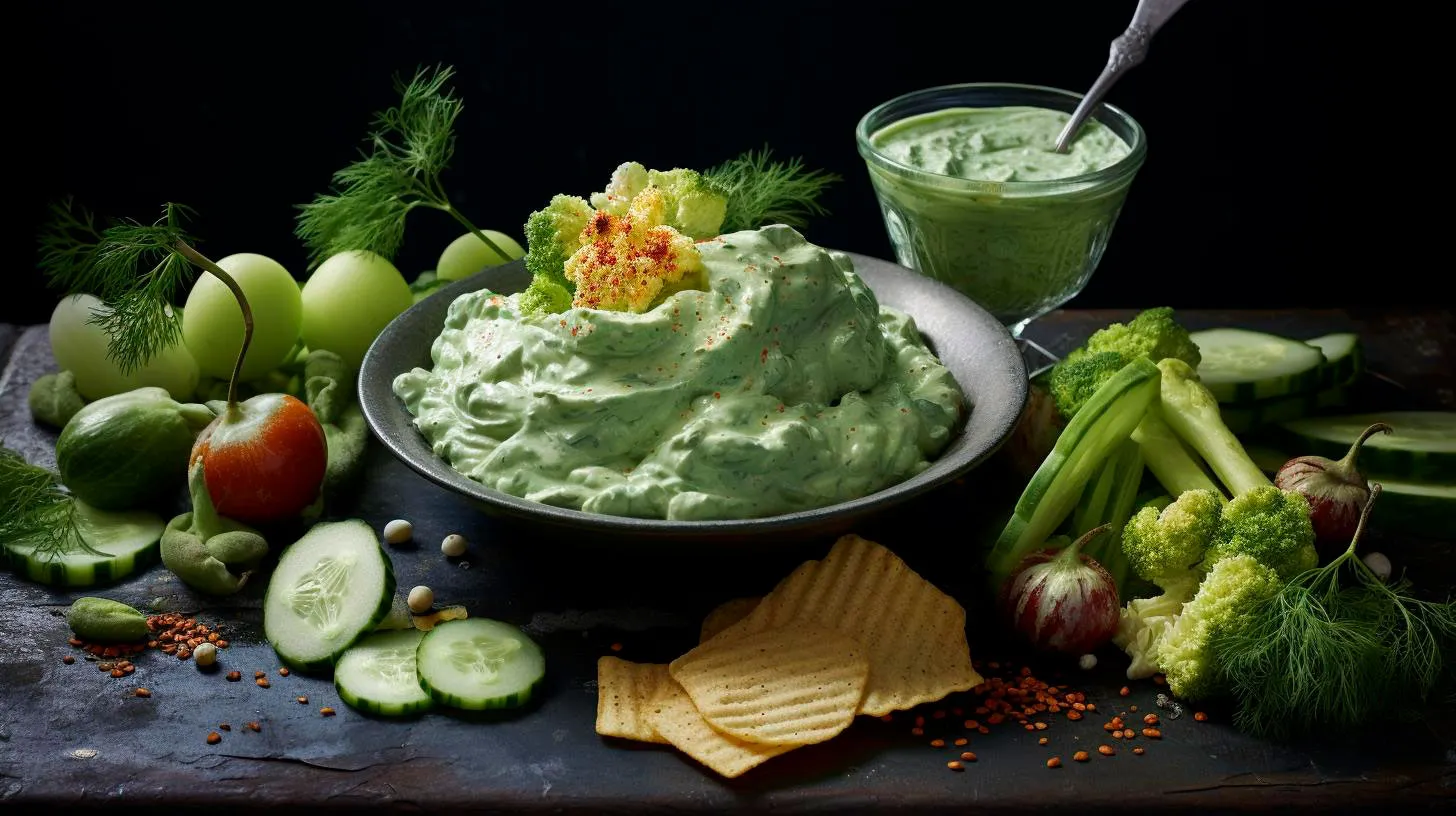Sushi Evolution: Reinventing Traditional Japanese Cuisine
In this article, we explore the evolution of sushi and how it has established itself as an international culinary masterpiece.
The Origins of Sushi
Before delving into the evolution, let’s understand the origins of sushi. Dating back to the 8th century in Japan, sushi was first developed as a method of preserving fish. Rice, fermented with vinegar and salt, was used to wrap the fish, allowing it to be stored for months. This ancient preservation technique laid the foundation for the modern-day sushi we enjoy.
For centuries, sushi remained a regional delicacy within Japan. However, in the 19th century, the sushi world experienced a significant transformation due to the introduction of refrigeration technologies. This breakthrough revolutionized the sushi industry, as it allowed for the distribution of fresh fish beyond coastal areas.
The Evolution Begins: Nigiri and Maki Sushi
The true evolution of sushi began with the introduction of nigiri sushi in the 19th century. Nigiri sushi is a hand-pressed style, where a small mound of sushi rice is topped with a slice of raw or cooked fish. This innovation allowed the delicate flavors and textures of the seafood to be savored, elevating sushi to new heights.
- Advantage: Nigiri sushi showcases the pure essence of the fish, allowing it to shine.
Another notable sushi innovation during this period was the birth of maki sushi. Maki sushi is made by rolling sushi rice and various ingredients in seaweed, known as nori. This technique further expanded the possibilities of sushi, introducing a range of fillings such as vegetables, seafood, and even fruit.
- Advantage: Maki sushi offers diverse flavor combinations, appealing to a wider range of palates.
Sushi Travels Across the Pacific
Fast forward to the 20th century, sushi began to captivate the Western world. The popularity of sushi skyrocketed in the United States during the 1960s, primarily driven by the growing interest in Japanese culture. However, its initial acceptance outside of Japan faced several challenges due to cultural differences and the perception of raw fish consumption.
In response to these barriers, sushi chefs started to adapt their creations to appeal to Western tastes. This resulted in the creation of familiar options like California rolls, where traditional ingredients were replaced with avocado, cucumber, and cooked crab.
- Key Takeaway: Sushi adapted to diverse cultural preferences, making it more accessible to a global audience.
The Fusion Era: Sushi Reinvented
In recent years, sushi has not only been about adapting to Western palates but has also embraced fusion cuisine. Sushi restaurants worldwide now experiment with diverse ingredients and flavors, combining Japanese tradition with global culinary influences.
One of the remarkable sushi creations born out of this fusion era is the “spicy tuna roll.” Mixing heat and texture, this roll combines spicy tuna with a touch of mayonnaise, resulting in a delectable fusion of flavors.
- Feature: The spicy tuna roll is a prime example of how traditional sushi can be reinvented with a modern twist.
Additionally, sushi has also embraced vegetarian and vegan options, catering to the growing demand for plant-based alternatives. Innovative rolls made with ingredients like tofu, avocado, and tempura vegetables showcase sushi’s adaptability to changing dietary preferences.
Sushi in the Digital Age
The evolution of sushi goes beyond culinary innovations; it also extends to the digital realm. Technology has played a significant role in enhancing the accessibility and convenience of sushi for consumers worldwide.
The rise of online ordering and delivery platforms has made sushi readily available at the click of a button. Additionally, sushi restaurants leverage social media platforms to showcase their creations, enticing customers with visually appealing photos and videos.
- Advantage: The digital age has allowed sushi to reach a broader audience and connect with food enthusiasts globally.
The Future of Sushi
As sushi continues to evolve, it is essential to preserve its traditional roots while embracing innovation. The future of sushi lies in striking a balance between honoring heritage and experimenting with new flavors, techniques, and presentation.
Key Takeaways:
- Sushi originated as a method of preserving fish and has evolved significantly over time.
- Nigiri and maki sushi were pivotal innovations that expanded the diversity of sushi.
- Sushi’s journey from Japan to the Western world led to adaptations and the creation of fusion rolls.
- The digital age has made sushi more accessible and allowed for creative showcasing.
- The future of sushi lies in bridging tradition and innovation while catering to evolving dietary preferences.
In conclusion, sushi has undergone a fascinating evolution, capturing the hearts and taste buds of people worldwide. From its humble beginnings as a preservation technique to its current status as a global culinary phenomenon, sushi beautifully blends tradition and innovation. With every bite, we savor the rich history and endless possibilities of this iconic Japanese delicacy.
Sushi as Art: Pushing Boundaries with Innovative Presentation
In this article, we explore the fascinating world of sushi as art, delving into the incredible techniques and trends that have revolutionized the way sushi is presented.
The Art of Sushi Presentation
Traditional sushi-making is an intricate process that involves precision, balance, and a deep understanding of flavors. However, it is the presentation that elevates sushi to an entirely new level. With attention to detail and creativity, chefs transform sushi into miniature works of art that are not only visually stunning but also enhance the dining experience.
- Visual Appeal: The presentation of sushi involves vibrant colors, contrasting textures, and meticulously arranged ingredients that create an aesthetic masterpiece on the plate. From delicate flower-shaped carrot slices to intricate patterns made with edible flowers, sushi chefs have mastered the art of visual appeal.
- Edible Garnishes: Alongside the sushi rolls or nigiri, chefs often include edible garnishes to enhance the dish’s presentation. These may include microgreens, edible flowers, or even gold leaf, adding a touch of elegance and luxury to the final creation.
- Plating Techniques: Sushi presentation isn’t limited to the traditional rectangular plate. Chefs use various plating techniques to present their creations. From artistic arrangements on slate boards to minimalist presentations on wooden platters, the possibilities are endless.
The Rise of Fusion Sushi
The world of sushi has evolved beyond traditional boundaries, with fusion sushi gaining immense popularity. Fusion sushi combines traditional Japanese techniques with flavors and ingredients from different cuisines, resulting in a delightful fusion of tastes and textures. This innovative approach extends not only to the flavors but also to the presentation, creating a compelling visual experience for diners.
- Unconventional Ingredients: Fusion sushi introduces unconventional ingredients that are not typically found in traditional sushi. These might include avocado, cream cheese, truffle oil, or even fruits like mango or pineapple. This blending of diverse ingredients adds exciting flavors and textures to the dish.
- Fusion Rolls: Sushi rolls, such as California rolls or spider rolls, are perfect examples of fusion sushi. These rolls often incorporate unique combinations, such as tempura shrimp, spicy mayo, and avocado, creating a harmonious balance of flavors.
- Exquisite Presentations: Fusion sushi takes presentation to the next level by incorporating artistic elements from different cultures. Chefs might incorporate delicate garnishes, like wasabi foam or soy sauce caviar, transforming the sushi into dazzling creations that are almost too beautiful to eat.
The Influence of Social Media
In today’s digital age, the presentation of sushi has gained even more significance due to the influence of social media. Instagram, in particular, has become a platform where chefs showcase their artistic sushi creations, attracting worldwide attention. This trend has brought about a new wave of creative sushi presentations, as chefs strive to create visually striking masterpieces that are Instagram-worthy.
- Colorful and Eye-Catching: Chefs now utilize vibrant colors, unique plating techniques, and unusual garnishes to capture the attention of social media users scrolling through their feeds. Sushi that is visually appealing and aesthetically pleasing tends to attract more likes and shares.
- Interactive Elements: To engage viewers on social media, chefs often incorporate interactive elements into their sushi presentations. This might include surprising textures or hidden fillings that are revealed with the first bite, creating a sense of anticipation and delight.
- Behind-the-Scenes Glimpses: Social media has also given chefs the opportunity to share behind-the-scenes glimpses into their creative process. By documenting their techniques and inspirations, they not only showcase their talent but also inspire other aspiring sushi chefs to experiment and innovate.
Key Takeaways
The art of sushi presentation continues to captivate the culinary world, constantly pushing boundaries and inspiring innovation. Here are the key takeaways from this exploration of sushi as art:
- Sushi presentation goes beyond taste, creating visually stunning and aesthetically pleasing culinary creations.
- Chefs utilize vibrant colors, edible garnishes, and unique plating techniques to enhance the visual appeal of sushi.
- Fusion sushi blends flavors and ingredients from various cuisines, resulting in both unique taste experiences and exceptional presentations.
- Social media has played a significant role in shaping sushi presentation, with chefs now focusing on creating shareable, visually striking creations.
As sushi continues to evolve, both as a culinary delight and an art form, the possibilities for innovative presentation techniques are limitless. Whether you’re a sushi enthusiast or a chef, embracing this artistic approach to sushi can elevate your dining experiences and inspire your culinary creations.
Exploring the World on a Platter: Global Flavors Meet Sushi
From traditional rolls to innovative combinations, sushi has evolved into a culinary masterpiece that beautifully blends global flavors. Let’s dive into the world of sushi, where different cultures meet on a single platter.
A Fusion of Flavors
Sushi, in its essence, is a delicate art form that combines simplicity with complex taste profiles. Traditionally, sushi consisted of vinegary rice, fresh fish, and seaweed. However, the art has evolved over time, embracing ingredients and flavors from various parts of the world.
Today, sushi aficionados can enjoy an astonishing range of flavors, thanks to the fusion of global culinary techniques. This fusion has opened up endless possibilities for both traditional sushi chefs and adventurous food enthusiasts. Here are some examples:
- Spicy Tuna Roll: Combining the freshness of raw tuna with the spiciness of jalapenos, this roll is a perfect example of Mexican and Japanese fusion. The heat of the jalapenos beautifully complements the rich flavors of the tuna.
- Tempura Sushi: Originating from Japan, tempura sushi brings together the delicate flavors of tempura-battered seafood with the elegance of sushi rolls. This fusion creates a delightful contrast between the crispy exterior and the soft interior of the roll.
- Sushi Burrito: A popular fusion creation from the United States, the sushi burrito combines the convenience of a burrito with the flavors of sushi. Packed with fresh fish, vegetables, and sushi rice, this oversized roll offers a unique experience for sushi lovers on the go.
The Advantages of Fusion Sushi
The fusion of flavors in sushi has numerous advantages that make it an appealing choice for food enthusiasts worldwide. Some key takeaways include:
- Expanding Flavor Profiles: By incorporating global flavors, fusion sushi broadens the palate and allows a wider range of taste experiences.
- Cultural Exchange: Fusion sushi bridges culinary traditions and brings cultures together. It allows people to appreciate and celebrate different cultures through their cuisine.
- Creative Expression: Sushi chefs have the freedom to experiment and create new flavor combinations, pushing the boundaries of traditional sushi. This creativity keeps the culinary world excited and eager for the next innovative creation.
Statistics Speak
The popularity of sushi and its fusion with global flavors can be witnessed through some fascinating statistics:
- According to Statista, the global sushi market is expected to reach a value of $22.2 billion by 2025.
- As reported by the Nikkei Asian Review, the United States alone consumes around 2 billion plates of sushi each year.
- A survey conducted by Technomic found that 76% of consumers in the United States try sushi for its unique flavors.
Key Takeaways
Sushi has evolved from a traditional Japanese delicacy to a global sensation that embraces flavors from all around the world. With fusion sushi, food enthusiasts have the opportunity to experience an array of taste sensations that combine the elegance of sushi with diverse culinary traditions. Some key takeaways include:
- Fusion sushi brings together global flavors, expanding the taste profiles of traditional sushi.
- It promotes cultural exchange, allowing people to appreciate and celebrate different culinary traditions.
- Chefs have the creative freedom to experiment with innovative flavor combinations, keeping the culinary world excited and evolving.
So why not embark on a culinary adventure and explore the world on a platter? Indulge in the divine taste of fusion sushi and discover the seamless blending of cultures that makes sushi truly a global treasure.
Fusion Fare: When Sushi Meets Unexpected Ingredients
The Rise of Fusion Fare
In recent years, fusion cuisine has taken the culinary world by storm. It offers a fresh take on traditional dishes, merging different cooking styles and flavors to create something new and exciting. Sushi, with its infinite possibilities, lends itself well to fusion experimentation.
By infusing sushi with unexpected ingredients, chefs are able to push the boundaries of taste and texture. From a fusion roll combining elements of Japanese and Mexican cuisine to a sushi burrito brimming with bold flavors, fusion fare has transformed sushi into an adventurous culinary delight.
Unexpected Ingredients, Exquisite Flavors
Fusion sushi is where innovation meets tradition. Chefs artfully blend traditional sushi components, such as seafood and rice, with unexpected ingredients to create an explosion of flavors. Here are some examples of fusion sushi that showcases this unique blending:
- Spicy Tuna Tempura Roll: This roll combines the heat of spicy tuna with the crunchiness of tempura, creating a mouthwatering sensation.
- Mango Avocado Sushi: By adding the tropical sweetness of mango and the creamy richness of avocado to sushi, this roll brings a unique burst of flavor to the palate.
- Teriyaki Chicken Sushi: This fusion delight combines the savory flavors of teriyaki chicken with the delicate texture of sushi rice, offering a delightful twist on traditional sushi.
These are just a few examples of the countless fusion sushi creations found in restaurants around the world. The combination of unexpected ingredients creates flavor profiles that will tantalize your taste buds and leave you craving for more.
The Advantages of Fusion Fare
Fusion sushi not only offers a unique gastronomic experience but also provides several advantages:
- Expands Culinary Horizons: Fusion fare allows you to discover exciting new flavors and combinations that you may have never experienced before, expanding your culinary horizons.
- Perfect for Adventurous Eaters: If you enjoy trying new things and are open to bold flavor combinations, then fusion sushi is tailor-made for you.
- Accommodates Dietary Preferences: Fusion sushi can accommodate various dietary preferences and restrictions, making it an inclusive choice for many.
Key Takeaways
Fusion sushi combines the traditional elements of sushi with unexpected ingredients, resulting in a culinary experience that is both unique and delightful. Here are the key takeaways:
- Fusion sushi is a result of blending traditional ingredients with unexpected flavors and textures.
- It offers an innovative twist on traditional sushi, allowing chefs to experiment with diverse cuisines and ingredients.
- Fusion sushi expands culinary horizons and provides an exciting gastronomic adventure.
- It accommodates various dietary preferences, making it a versatile choice for many.
Next time you find yourself craving sushi, why not embark on a fusion fare journey? Explore the vibrant world of flavors and textures that fusion sushi has to offer, and delight in the unexpected combinations that will leave your taste buds wanting more.



